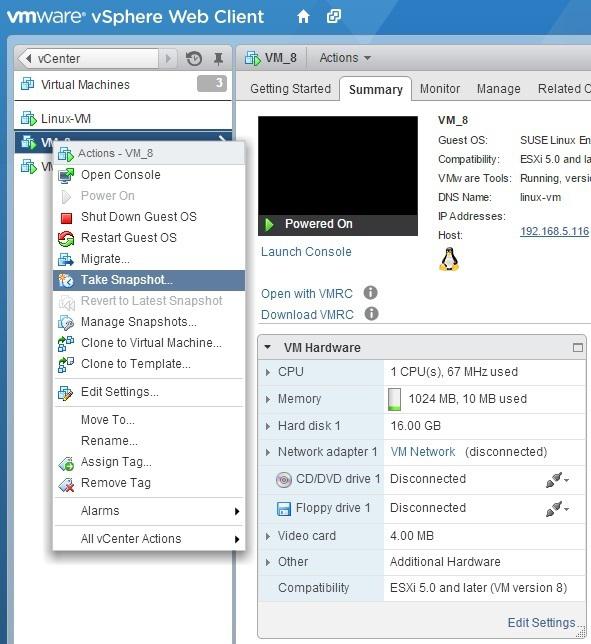You can take one or more snapshots of a virtual machine to capture the settings state, disk state, and memory state at different specific times. When you take a snapshot, you can also quiesce the virtual machine files and exclude the virtual machine disks from snapshots.
When you take a snapshot, other activity that is occurring in the virtual machine might affect the snapshot process when you revert to that snapshot. The best time to take a snapshot from a storage perspective, is when you are not incurring a large I/O load. The best time to take a snapshot from a service perspective is when no applications in the virtual machine are communicating with other computers. The potential for problems is greatest if the virtual machine is communicating with another computer, especially in a production environment. For example, if you take a snapshot while the virtual machine is downloading a file from a server on the network, the virtual machine continues downloading the file and communicating its progress to the server. If you revert to the snapshot, communications between the virtual machine and the server are confused and the file transfer fails. Depending on the task that you are performing, you can create a memory snapshot or you can quiesce the file system in the virtual machine.

When you capture the memory state, the virtual machine's files do not require quiescing. If you do not capture the memory state, the snapshot does not save the live state of the virtual machine and the disks are crash consistent unless you quiesce them.
Quiesced SnapshotsWhen you quiesce a virtual machine, VMware Tools quiesces the file system of the virtual machine. A quiesce operation ensures that a snapshot disk represents a consistent state of the guest file systems. Quiesced snapshots are appropriate for automated or periodic backups. For example, if you are unaware of the virtual machine's activity, but want several recent backups to revert to, you can quiesce the files.If the virtual machine is powered off or VMware Tools is not available, the Quiesce parameter is not available. You cannot quiesce virtual machines that have large capacity disks.
Important: Do not use snapshots as your only backup solution or as a long-term backup solution.
PREV: Solution for could not connect to one or more vCenter Server ...
NEXT: Could not connect to one or more vCenter server systems 443 ...